One of the earliest depictions of an elephant in Middle Eastern history appears on Shalmanezer’s black obelisk (dated around 860 BC). The scene is that of Shalmanezer receiving tribute, presumably from Egypt (Musr). The illustration of the elephant and monkeys makes clear the artist was not familiar with these wonderful beasts. While the elephant seems to have been unknown in the Middle East, from Indian records we learn that the Asian elephant was used in battle as early as 1100 B.C.
History of War Elephants
During the exploits of Alexander the Great, the Greek army met the Persian army at the battle of Gaugamela, where they faced fifteen elephants. This was the first time the Europeans had come up against war elephants.
Later in India, the Macedonians had to face up to 200 elephants at the battle of Hydaspes in modern Pundjab. (326 BC) They were lined up at 30 meter intervals in front of the whole army. Their prime object then, as it was later, was to stop the cavalry. Horses do not like the smell of elephants. The Macedonian light infantry first attacked the elephants with javelins, trying to kill the animals or the drivers. Finally, Alexander gave orders for the rear half of the phalanx to move up into the intervals between the files to form locked shields formation, presenting the elephants with a mass of spears, and in this formation, they drove them back. Alexander captured 80 elephants, and during future campaigns, he was able to gather as many as 200 elephants into his army.
At the end of the 4th century BC, one of Alexander’s captains, Seleukos Nikator, tried to invade India. After an unsuccessful campaign, he sued for peace and gave his daughter in marriage to the victorious emperor in exchange for 500 elephants of war.
Now that the Europeans hand been introduced to elephants, for better or worse, every self-respecting army had to have them. For over 100 years they were the great gimmick.
The Mauryan kings who succeeded Alexander in controlling parts of Asia had a highly organized system for the maintenance of their herds of elephants. The Arthasva’stra (2.31-32), a treatise of government most probably dating to the Mauryan period, reviews the responsibilities of the king’s elephant keeper, under whom worked physicians, trainers, riders, foot-chainers, stall-guards, and other attendants. Reserves were maintained for the elephants, where the animals were allowed to live in a semi-feral state while guards observed their movements and kept careful records (2.2.6-11). These elephants were then captured as needed for military or other purposes. These practices are verified by references in the extant inscriptions of the Mauryan king Asvoka.
As the first elephants to be used in the Mediterranean were obtained from India, it is predictable that Indian methods of organization would be adopted. A position of elephantarch was established by the successors of Alexander in their respective realms (Plutarch, Demetrius 25,), and the term Indov’ was appropriated to refer to elephant drivers in respect to the first Indians who trained the Greek kings’ elephants (Polybius 1.40.15).
The armies of Alexander’s successors used elephants almost exclusively against cavalry. Occasionally they were used in siege warfare for such jobs as tearing down wooden fortifications. When drawn up for battle, the intervals between the animals were filled with light-armed troops. At the battle of Gaza (312 BC) there was a unit of 50 javelineers, slingers and archers (of whom a third were bowmen) in each interval. Diodorus implies that this was the standard number of light armed men per elephant. The elephant’s main weak spot was the soles of its feet. At the siege of Megalopolis (318 BC) heavy wooden frames studded with iron spikes were laid in the path of the elephants. At the battle of Gaza spiked devices, possibly caltrops, connected by chains were thrown in front of them.
In 280 BC, Alexander’s kinsman, Pyrrhus invaded Italy and introduced the Romans to these living tanks. As the war was centered mainly on Lucania, elephants received the nickname of Lucanian cows. All the elephants so far mentioned were Indian.
As late as the Roman Empire all known war elephants seem to come from India, via the Parthian / Sassinid Empire. Pliny the Elder writes about these elephants at some length at the beginning of Book 8. Pliny knew that the elephant’s tusks were teeth, not bones. He seems unaware of elephants from south of the Sahara Desert and usually speaks of India as the source of elephants.
Some historians believer that Alexander the Great Egypt did import occasional elephants up the Nile River from central Africa, but never in quantity.
When Alexander died, his kingdom was split between his generals. The Selucids of Syria had access to elephants from India, but the Ptolmys were cut off in Egypt where elephants were very hard to come by. The use of elephants gave the Selucids a tactical military advantage against the Ptolemies of Egypt.
In order to counteract this tactical deficit, Ptolemy Philadelphos decided to import African elephants into his army. In order to do this as fast as possible, he needed to move elephants from central Africa, north as fast as possible. So Philadelphos developed a series of ports on the Red Sea and farther down the East Africa coast, complete with elephant stopping stations. The ports of Philotera and Berenice were developed and the Egyptian port of Myos Hormos was improved.
Elephants were then captured, trained and eventually moved from the south to Egypt via Egyptian ships and the new Egyptian ports. As this took time, these elephants did not appear in Ptolemic armies until near the end of Philadelphos’ rule.
Polybus, in his description of the battle of Raphia, (217 BC, the year after Hannibal crossed the Alps) fought between the Ptolomies and the Selucids, mentions that the African elephant was smaller than the Indian.
This has led to a storm of controversy as, of course the opposite is true. This was often quoted as an example to show that Polybius was not as well informed as his admirers claimed. However, in more recent years it has been shown that there was a species known as the North Africa elephant, which was common in North Africa in Polybius’ day but is now extinct. This species measures about 2.35 meters at the shoulder, whereas the Indian measures just under 3 meters and the African bush type about 3.5 meters, and the Syrian may have reached 3.6 meters or more. During his account of the battle of Raphia, Polybius gives a vivid description of elephants fighting each other. They met dead on with tusks interlocked. Each pushed with all its weight, trying to compel the other to give ground. Finally, the stronger would force the weaker one’s trunk to one side and then gore him in the exposed flank.
Although the Indians who opposed Alexander did not use towers on their elephants, the Indian elephant was large enough to be fitted with one. Towers seem first to have been used by Pyrrhus when he invaded Italy. The North African forest type was rather too small to carry a tower and certainly the Carthaginians never seem to have used them. However, at Raphia, Ptolemy’s elephants clearly carried them. The smaller African bush elephants with their saddle backs would usually have been ridden like a horse.
War elephants are described in the books of 1 & 2 Maccabees, books found in Catholic Bibles and the Apocrypha of Protestant Bibles, especially 1 Macc 6 and 2 Macc 13-15. These were most likely Indian war elephants as 1 Maccabees describes their driver as being Indian. Upon the backs of the elephants were wooden towers filled with fighting men.
In 250 BC, Pyrrhus, the king of Epirus (now North Albania), with an army of 25,000 men and 26 elephants won a hard-fought victory over the Romans at Heraclea. At a crucial phase of the battle, Pyrrhus ordered his elephants to charge and it was too much for the Roman legions.
In 218 BC the elephant reached the height of its fame when Hannibal crossed the Alps at the head of an army which included 37 elephants. But the difficulties of the terrain and the climate proved too hard for the bulky-bodied elephants and many of them perished on the way. Nevertheless, Hannibal’s military genius and Carthaginian fortitude triumphed in the end. When the Roman General Publius Cornelius Scipio (BC 185-129) invaded Carthage and defeated Hannibal at the Battle of Zama in BC 202, the Carthaginians found their elephants to be more a liability than an asset.
Some historians feel that these elephants were African bush elephants, and others say they were North African elephants, and still others feel they must have been Indian elephants, while one of Hannibal’s elephants was known as “Sarus,” which means “the Syrian.” This elephant was very large and was the outstanding animal in the elephant battle squadron.
Eventually, however, the heyday of the elephant was over and they soon fell out of favor. It is felt that their use may have declines because of the difficulty of obtaining them.
Classifications of Elephants
There are, and were many different species of elephants. Today, only two main species exist, but in the time of the Nabataeans, four separate species were known at that time, and could have been used for warfare.
One thousand years earlier, several races of the Asian and African elephants had become extinct. (about 1500 BC.) For example, the Elephas maximus rubridens existed in China as far north as Anyang, in northern Honan Province. Writings from the 14th century BC state that elephants were still to be found in Kwangsi Province. The small North African race became extinct by the 2nd century BC. The large African bush elephants (Loxodonta africana) were exterminated from the Transvaal region of South Africa early in the 20th century, but they still occur over much of the continent south of the Sahara Desert. The African forest elephant still inhabits the forests of western equatorial Africa, particularly in the Congo region. It is considered by some to be a subspecies (Loxodonta africana cyclotis) of the African elephant; others believe it to be represented by several subspecies; still others consider it to be a separate species (L. cyclotis).
The African elephant can be quickly distinguished from the Indian elephant by its greater size and its larger ears, which may reach a length of 1.5 meters (5 ft) from top to bottom. The African elephant is tallest at the shoulder, has more wrinkled skin, and bears tusks in both male and female. The Indian elephant is tallest at the arch of the back, bears noticeable tusks in the male only (the female having tusks so small that they appear absent), and has one lobe instead of two on its trunk. The Indian elephant has two humps on its forehead, the African elephant’s forehead is flatter.
The ears are said to reflect the geographical local from which they originate. The Indian elephant has smaller ears, shaped like the Indian subcontinent. The African elephant has larger ears, reminiscent of the shape of the large African continent.
Despite their great weight, which in African elephants reaches 7,000 kg (15,400 lb) and in Indian elephants 5,000 kg (11,000 lb), elephants walk almost noiselessly and with exceptional grace, their columnar legs keeping their bulk moving forwards in smooth, rhythmic strides. A thick cushion of resilient tissue grows on the base of the foot, absorbing the shock of the weight and enabling the animal to walk high on its hoof-like toes. Elephants normally walk at about 6.4 km/h (4 mph) and can charge at up to 40 km/h (25 mph). They cannot gallop or jump over ditches, but they readily take to rivers and lakes, where the water supports them and enables them to swim for long distances without tiring.
Although African elephants can be trained, the Indian elephant has by far the longer tradition of service to humankind. Indian elephants are still used for logging, especially in mountainous terrain, and were probably employed as work animals as early as 2000 BC.
Both species live in habitats ranging from thick jungle to savanna. They live in small family groups led by old cows; where food is plentiful the groups join in larger herds. Most bulls live in bachelor herds apart from the cows. Elephants migrate seasonally, according to the availability of food and water. They spend many hours eating and may consume more than 225 kg (500 pounds) of grasses and other vegetation in a day. Gestatioon averages 22 months. Maturemale elephants annually enter a condition known as musth, which is marked by secretions from the musth glands behind the eye, an increase in aggression, and association with females that usually leads to mating.
Since elephants rarely bear young in captivity, they are corralled (kept in an enclosure) in the wild, often with the use of domestic elephants and mahouts (professional elephant handlers). A captured calf is assigned a keeper, who remains with it for life, training it when it reaches 14 years of age and putting it to hard labor at age 25 years. This type of capture is becoming less frequent, except in cases where animals that are destroying farmers’ crops are captured and relocated in the wild.
The life-span of an elephant rarely exceeds 70 years. An average elephant eats about 300 lbs. of green food per day. Unless on the move, it spends most of the time in filling its belly, which is similar to a wasteful factory consuming more fuel than necessary. The intake of water is also high, and an elephant siphons about 20 gallons of water at a time by making use of its trunk. During drought, herds of elephants move in search of water to quench their thirst and also to squirt water over their bodies beaten by the hot sun.
Elephants drink by sucking water up into the trunk and then squirting it into the mouth. They eat by detaching grasses, leaves, and fruit with the tip of the trunk and using it to place this vegetation in the mouth. By means of a small, fingerlike projection on the tip of the trunk–African elephants have two of these extremities and Indian elephants have one–they are able to pick up small objects.
The Asian or Indian Elephant
Elephas maximus The Elephas maximus is native to the Indian subcontinent and southeastern Asia; and lives in habitats ranging from thick jungle to savanna. They live in small family groups led by old cows. Where food is plentiful the groups join in larger herds. Most bulls live in bachelor herds apart from the cows. Elephants migrate seasonally, according to the availability of food and water. They spend many hours eating and may consume more than 225 kg (500 pounds) of grasses and other vegetation in a day. Gestation averages 22 months. Mature male elephants annually enter a condition known as musth, which is marked by secretions from the musth glands behind the eye, an increase in aggression, and association with females that usually leads to mating. For many centuries the Indian elephant has been important as a ceremonial and draft animal. Commanded by its handler (or mahout), the elephant has been basic to Southeast Asian logging operations.
Indian Elephants had legs that were almost cylindrical and the females carry underdeveloped tusks or none at all. Many males are without tusks as well. Male Ceylon elephants are generally tusk-less. Their skin is pale gray changing to reddish pink flesh along the trunk, throat, chest and belly.
Statistics:
Shoulder height: 2,5 to 3 meters
Body length: 5,5 to 6,5 meters
Weight: up to 5 tons
Typical features:
Noticeable bulges on the forehead
Front and hind legs of nearly equal length
Five hooves on each front foot, four on each hind foot Medium-sized ears, with the upper and inner edges folded over
Only one finger on the tip of the trunk
The African Plains Elephant
loxodonta africana oxyotis
This elephant is the largest of all the living elephants measuring 3.5 to 4 meters at the shoulder. The African plains elephant is easy to differentiate from other elephants, it has very large ears, four hooves at each front foot, and its front legs are noticeably longer than the hind legs. When elephants are excited about anything, they spread their ears and bring them in line with their forehead. In order to increase the effect of this threatening posture, ancient war elephants were occasionally deployed with their heads and ears painted red, white, or yellow.
In 1955, a gigantic elephant was shot down near the Cuando River in South Africa. It measured 13 feet and 2 inches at the shoulder, weighed 15 tons, and each tusk measured 14 feet from base to tip. It is said that a mounted specimen of this huge tusker could be seen at the Smithsonian Institute in Washington, US. Generally, most African elephants have long tusks weighing about 400 lbs. each. The tusks of old elephants are said to contain a kind of pearl known as ‘gaja-muthu’ and believed to be the most durable of pearls. Pearls are calcareous (chalky) substances that grow from lustrous globules or granules, and such concretions of nacre found with the tusks are highly priced for their beauty and quality.
Statistics:
Shoulder height: 3,5 to 4 meters
Body length: 6,5 to 7,5 meters
Weight: about 6 tons
Typical features:
Flat forehead
Front legs noticeably longer than hind legs
Four hooves on each front foot, three on each hind foot Very large ears Two opposite fingers on the trunk
Females and males carry large tusks. In rare cases, males may have tusks up to 3.5 m long.
Skin is Slate blue gray and often colored pale brown by dirt and dust.
African Forest Elephant
Loxodonta africana cyclotis
Some scientists consider the African Forest Elephant to be a subspecies of the African Plains Elephant. But modern research has shown that the Forest elephants appear to be genetically distinct. They are smaller and have straighter and thinner tusks than their Savannah cousins, and they have rounded ears and distinct skull morphology. But although they have sometimes been regarded as a subspecies, DNA research has shown that the Savannah populations in southern, eastern and north central Africa, although widely separated, were genetically indistinguishable, while the forest animals shows more genetic diversity.
The Numidians used African forest elephants in battle. Many of these animals were captured in the woods of the Atlas mountains. These relatively small animals could not carry a tower, they were ridden by a crew of two or three men. The Mahout controlled the animal, and the other two men were armed with bow and arrows, or javelins.
The African forest elephant had rounder ears and they would stand straight out when the animal is agitated in a combat situation. The African elephant has thin legs and large, saucer-shaped feet with four hooves.
African forest elephants were captured and tamed by the Numidians, who used them in battle. However, these animals were too small to carry a tower, they were straddled and ridden like horses. A Numidian mahout drove the animal and behind him sat an archer and a lance-armed infantryman. The infantryman’s lance is 5.5 m long, it was called a sarissa. The African forest elephant typically carried an archer or two who knelt on the back of the animal or straddled it like a horse.
Statistics
Shoulder height: up to 2.35 meters
Typical features:
Flat forehead
Front legs noticeably longer than hind legs
Four hooves on each front foot, three on each hind foot Small round ears Two opposite fingers on the trunk
Females and males carry large tusks.
Skin is slate blue gray
The African Cape Elephant
Loxodonta africana africana
The South African Cape Elephant forms the third subgroup of the African elephants. The Cape Elephant is similar in size and appearance to the African plains elephant. African elephants are the largest land mammal in the world. Both the male and the female have tusks. The head had large fan-like ears and a large, sloping forehead. The trunk is made up of more than 40,000 muscles and has two finger-like projections. The bottom of the feet are covered with thick pads. They have 6 sets of teeth.
Statistics:
Adult height: 3 - 4 meters tall at the shoulder
Adult weight: 2.5 - 7 tons
Approximate life span is 50-60 years. Diet Wild grasses, tree bark and fruits, also consume soil for mineral content
Social: live in tightly organized herds of females and offspring led by a matriarch, adult males form own herds or travel alone They communicate by a variety of sounds. In the wild they bathe 3 to 4 times a day and eat 300-500 pounds of vegetation every day. They have no natural enemies, are good swimmers
The Syrian Elephant
This species of elephant lived in Iran and Syria. Early drawings of the animal and fragmentary skeletal remains indicate that it was the largest subspecies of the Asian elephant. The war elephants employed by Pyrrhus in 255 BC and engraved upon Roman seals show animals of unusual size. “Sarus,” which signified “the Syrian,” was the outstanding animal in the elephant battle squadron of the Carthaginian general Hannibal.
Ancient Syrian craftsmen made ivory carvings out of the tusks of the elephants that lived on the Syrian steppe but by 100 BC this craft died out. Hippopotamus teeth were also a source of ivory for Syrian craftsmen. The hippopotamus was another animal that at one time lived on Syrian territory, along the Mediterranean coast, but it, too, had been hunted into extinction. Hippopotamus ivory was whiter than that obtained from elephants and was therefore more highly valued. In Syria, the production of ivory objects reached its apex at the beginning of the first millennium BC, when the Aramaeans made splendid ivory inlay for furniture; the disappearance of the elephant from Syrian territory was a consequence of the growth of this craft and the popularity of its luxury product.
The North Africa Elephant
This smaller species of elephant became extinct in 2nd century AD. It would have measured about 2.35 meters at the shoulder.
Nepalese Elephants
In February and March of 1992, the intrepid British explorer Sir John Blashford-Snell was trekking through a remote valley in the Bardia region of western Nepal in search of “giant elephants” reported by the locals. Two representatives of these strange elephants, both bulls, were eventually observed - and photographed. The two beasts, living up to their reputation, were estimated to have footprints measuring 22.5 inches across and a height to the shoulders of 11 feet 3 inches, which makes them even larger than the largest-ever recorded specimen of the Asian elephant. Adding to the confusion was the presence of two very large domes on each elephant’s forehead, and a distinctive nasal bridge. These two features are not present on normal Asian elephants, but are, however, distinct on an extinct species of primitive elephant, the Stegodont .
His discovery sent a buzz through the scientific community. The two bulls, named Raja Gaj and Kanji, are huge, Raja Gaj stands 3.7 meters tall, taller than the biggest Asian elephant on record, and weighs around seven tons.
These elephants have very distinctive characteristics which include sloping backs, ‘reptilian’ appearance of the tail, a swept-up forehead interrupted by a deep depression and a large dome-shaped hump on the top of their heads.
Obtaining DNA samples to compare with the DNA of mammoths (of which there are some samples) involves some difficulty. Also, neither mammoth nor modern elephants’ DNA has been properly sequenced yet. Nevertheless, using dung believed to be from these creatures, preliminary DNA testing is said to show that they are more similar to the Asian elephant than to the mammoth. Some speculate that these unique giants might represent some sort of ‘throwback’ due to unusual inbreeding.
But scientists are now not sure if the Nepalese Elephant is actually an elephant or some from of Mammoth. It’s interesting to note that recent Carbon 14 dating of mammoth remains date it at 4,000 years, although it was supposedly extinct 6,000 years earlier. Along with this, The Siberian Evenk tribe have well-preserved mammoth skins and claim that they still hunted mammoths, at the turn of the century.
Not long after the elephant discovery, another team of explorers has found a previously unknown breed of horse, grazing in a remote valley in Tibet, which looks exactly like those in ‘Stone Age’ cave paintings. Known as the Riwoche (pronounced Ree-woe-chay) horse, it has the same wedge-shaped head (zebras have this too), the same black stripe on its back, and black lines on its lower legs. Horses like this were supposed to be extinct thousands of years ago. One wonders if cave rock drawings depicting these creatures are as old as some archeologists claim.
War Elephants
After the Syrian and Indian elephants had proven their worth in battle, the Egyptians and Carthaginians deployed African Plains Elephants in the same role. These animals were tamed and prepared for battle in eastern Sudan and Tunisia. The Plains Elephant is much larger and heavier than the Indian elephant, but may have been smaller than the Syrian Elephant.
Properly armed and armored, the Plains Elephant became a formidable enemy for infantry and cavalry. The crew of a Carthaginian war elephant typically consisted of four men, the Numidian Mahout who controlled the animal, and three Carthaginian soldiers in the tower: officer, archer, and infantryman armed with the Sarissa, a lance 5 - 6 m long. The tower had rounded shields on the tower sides. The infantrymen were armed with a lance 5.5 m to 6 m long. The crew usually had an archer as well.
Accounts of the capture, diseases, and habitats of Indian elephants are found in the Arthasvanstra, the Mantannga-L’nlan, the Aristotelian corpus, and later Graeco-Roman treatments of these topics.
With regard to size of the elephant, we would expect the Indian perspective to be influenced by the social structure of Indian society. Just as ancient Indian society was divided into social classes, the Indian elephant was not viewed as a single generic group, but divided into four types: (Matanga-Lîla1.26-30; 6.3, 12.7)
bhadra - ‘state’,
manda - ‘slow’,
mr’ga - ‘deer’,
sam’kenrn’a - ‘mixed’
Elephants were thought to decrease in size through the descending ranks of the hierarchy. We can assume that the African elephant, to the extent that the Indians knew of its existence, was placed in the lowest of the four classes–the non-Aryan strata. Thus, from an Indian perspective, the African elephant, as a non-native, would be expected to be smaller in size than any Indian (Aryan) elephant.
Nabataeans and Elephants
When excavating the Great Temple in Petra, Dr. Martha Sharp Joukowsky of Brown University uncovered a series of massive columns around the building, each one using elephant heads to decorate the capitals. Each capital was decorated with four elephant heads. Several of these massive column capitals are located in the museum in the center of Petra.
It seems strange that the Nabataeans would use elephants as images on their buildings, especially on a building as important as the Great Temple, which might actually be the Royal Courts. Since war elephants had fallen out of use by 200 BC, why would the Nabataeans use them as a symbol one hundred and fifty years later? By this time, the use of war elephants would have been a distant memory.
After considerable study, Dr. Martha Sharp Joukowsky of Brown University has declared that the elephants on the Nabataean columns are Indian elephants rather than African elephants. Since only the head of the elephants were used by the Nabataeans, Dr. Martha Sharp Joukowsky had to come to this conclusion based on the limited information that the head provides for us.
However, I am not sure that these elephants are actually Indian elephants. I have visited the museum in Petra on many different occasions, photographing and examining the carvings. Below I have provided several pictures of the elephants of Petra. Under them are pictures of Indian and Africa war elephants. I will let you decide.
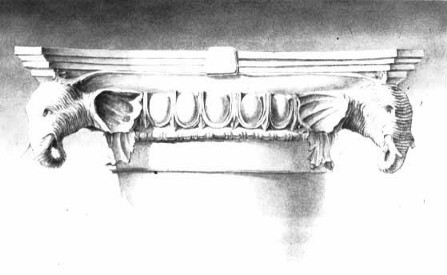
Reconstruction drawing of elephant capitals
This is a reconstruction drawing of the elephant capitals taken from Brown University Web Page. The drawings are very inaccurate and misleading however. I provide photos and sketches farther on in this paper.
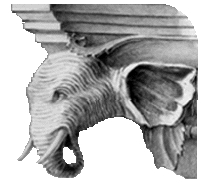
A reconstructed drawing of the elephant capitals from closer up. Borrowed from Brown University Web Page.

Indian elephant statue
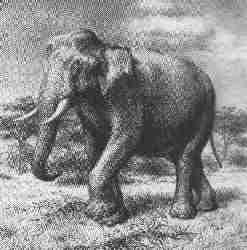
An Indian elephant
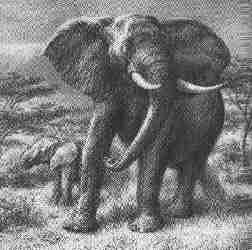
An African Plains elephant
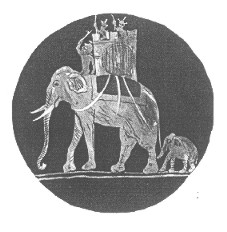
An Indian war elephant
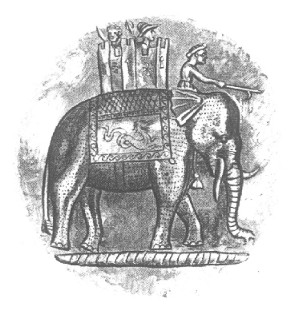
An Indian war elephant
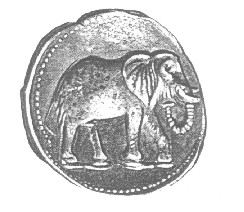
African elephant on a coin
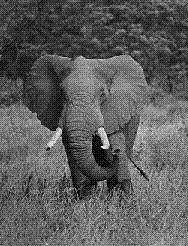
An African Plains elephant with ears extended
The Indian elephant should have smooth skin, a large hump on it’s forehead, and small ears. The African Plains elephant should have wrinkled skin, no hump, and large ears. The African Bush Elephant has a flat forehead, wrinkled skin, smaller rounded ears, and the male and females have tusks. Then of course, there is the extinct Syrian and also the North African elephant. I have not been able to obtain clear pictures or drawings of each.
Identifying the Nabataean Elephants
One summer, while talking to Dr. Martha Sharp Joukowsky at the dig site, she explained to me that she had concluded that the elephants were Indian elephants. I was pleased to hear this, as it seemed to provide one more connection between the Nabataeans and India. After some thinking, and going over the information included in this paper, I began to have grave doubts about the Indian’ness of the elephants. From a first observation, taking into account only the ears, this seemed to be a logical conclusion. But the ears bothered me. They seemed to be misplaced, and so they definitely did not look like African Plains elephant ears.
Several months later, on one of my regular trips to Petra I spent time again pondering the elephant ears. On this trip I carefully measured the elephants, photographed them and sketched them. The ears were definitely strange. And then, suddenly I understood.
The elephant columns are now set on several pillar pieces to bring them up to eye level. All of the published pictures I had seen of the elephants were from this angle. As Dr. Joukowsky was removing them from the site, I remembered that we were looking down at the capitals, as they came out of a hole in the ground. (They were covered with sand and dust deposits.)
But suddenly I realized that the original stone masons never intended for anyone to view the capitals in the position we were looking at them. The capitals were to rest on the top of high columns, and we were intended to look at them from below. So, laying on the floor of the museum, I began to photograph and sketch the elephants from below. Suddenly they took on a new form. The ears were now in the correct place, and as I stared up, an African Forest elephant with it’s ears flared out in an aggressive stance stared back at me.
I’m not sure if you, the reader will agree with me, so I have placed sketches and photographs below so you can reach your own conclusions.
Below: Pictures of the Nabataean Elephants in the Museum in Petra. On the right is an artists rendition of the photographs
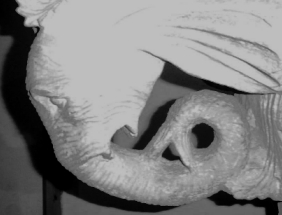
Nabataean Elephant sketched from the side
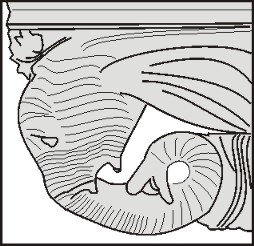
Nabataean Elephant photographed from the side
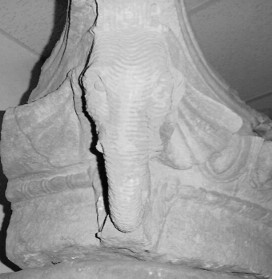
The elephants photographed from below
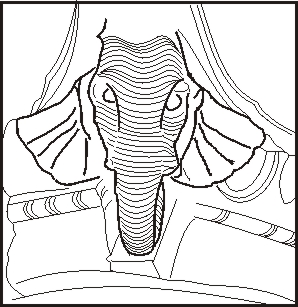
The elephants sketched from below
The next question, of course, is why would the Nabataeans identify themselves with an African Forest elephant? While the elephant displays power and majesty, I feel there must be something more. Surely there must have been some connection between the Nabataeans and this animal.
The closest connection I know of between the Nabataeans and the African Forest Elephant was during the wars between the Ptolomys and the Selucids. As I mentioned above, the Ptomoly’s set up a series of ports along the Red Sea in order to ship elephants from farther south up to Egypt.
If Ptolomy Philadelphos had to build ports, then it is obvious that no ports existed before hand, except the small port at Myos Mormos. If there were no major ports, then there was probably only a very small Egyptian merchant marine on the Red Sea. As I have pointed out in several of my other papers dealing with Nabataeans on the Red Sea, according to the ancient historians, the Nabataeans were transporting frankincense and myrrh from southern Yemen to their port at Leuke Kome. If Ptolomy Philadelphos was so desperate to add elephants to his army, that he built ports, roads, and training stations, then one would assume that he would hire whatever merchants he could from off the Red Sea to help him in his project. In this case, he may very well have used Nabataean sailors and ships to help transport the elephants from the ‘far ports’ in south eastern Africa to the northern ports of Berenice and Philoterast.
Certainly, not long after this, Nabataean boats began calling at these same ports with goods from southern Arabia, and eventually from India and beyond.
War Elephants?
Having done all this, one must ask the compelling question, are the elephants depicted on the columns, war elephants or were they used for some other use? And why elephants? Wouldn’t camel heads have been more appropriate, if the Nabataeans were indeed simply a tribe of camel caravan merchants? If the Nabataeans were, as I describe them in my book, also known as a tribe of entertainers, were the elephants used for entertaining? Africa was the major source for the wild animals that were used in the shows in Rome and other major cities of the empire. In particular panthers, lions, elephants, and monkeys were imported and put on display.
Conclusion
While it is possible to speculate about the elephants, without further knowledge we may never really understand fully the connection between the Nabataeans of the desert and elephants from the jungles of Africa. Hopefully more information will come to light as archeologists uncover more and more of the Nabataean past.
Bibliography
Bigwood, Elephants, AJPH 114, 549
Chadwick, The Fate of the Elephant, 32
Coleman, Loren. 1993. “Crypto-Zoo News,” Strange Magazine , Fall-Winter, p. 28-29
Connolly, Peter, Greece and Rome at War, Macdonald & Co. (Publishers) Ltd., London, 1981
Elephants take mammoth step out of an ancient past, The Sunday Mail (Brisbane), December 17, 1995, p. 57.
Encyclopedia Britannica, various articles
Encyclopedia Encarta, Microsoft Corporation, various articles
Lattakia Museum comments on *Syrian Ivor*y
Roesch, Ben, S., Living Stegodont or Genetic Freak?, Internet, 1995
Scullard, H.H., *The Elephant in the Greek and Roman Worl*d
Sick, David H. “Indian Elephants are Bigger than African: an Ancient Indian Perspective“
Shuker, Karl P.N. 1993. The Lost Ark . London: Harper Collins
Stone Age horse found in a lost world of Tibet, Sydney Morning Herald, November 15, 1995, p. 16.
The elephant that time forgot, The Mail on Sunday (Adelaide), May 23, 1993.
Toynbee, Animals in Roman Life and Art, 35
Wieland, Carl, Lost world animals found! Cave drawings brought to life by exciting new discoveries. Creation Magazine
Wylie, “Elephants as War Machines,” Elephants, Shoshani ed., 147
Are mammoths still alive?, Creation Magazine, Vol.15 No.4, p. 23 referencing ‘Nature and The Age’ (Melbourne).
Ancient Sources
Appian, Libyca 9
Arthasvanstra 2.31-32, an Indian historical document
Mantannga-L’nlan 1.26-30; 6.3, 12.7, an Indian historical document
Aristotelian corpus, and Indian historical document
Pliney, Book 8
Polybius 1.40.15
Plutarch, Demetrius 25
Ancient Inscriptions
Indian inscriptions: Minor Rock Edict II, I-K and Fifth Pillar Edict, line I
Shalmanezer’s black obelisk (dated around 860 BC)




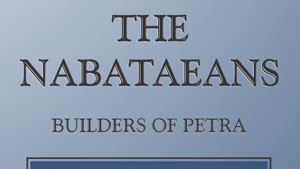



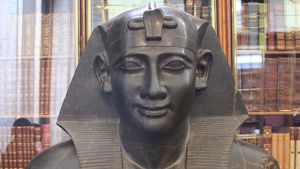
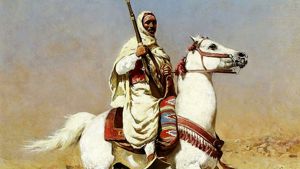
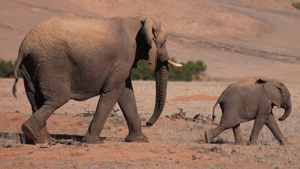
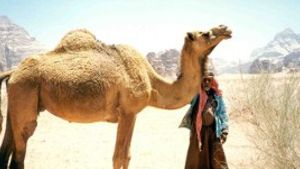

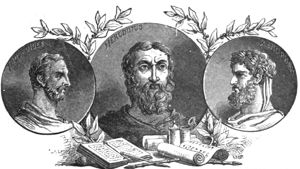




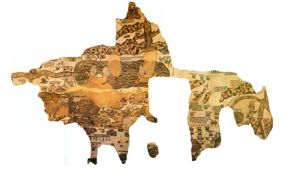

Page Discussion
Membership is required to comment. Membership is free of charge and available to everyone over the age of 16. Just click SignUp, or make a comment below. You will need a user name and a password. The system will automatically send a code to your email address. It should arrive in a few minutes. Enter the code, and you are finished.
Members who post adverts or use inappropriate language or make disrespectful comments will have their membership removed and be barred from the site. By becoming a member you agree to our Terms of Use and our Privacy, Cookies & Ad Policies. Remember that we will never, under any circumstances, sell or give your email address or private information to anyone unless required by law. Please keep your comments on topic. Thanks!